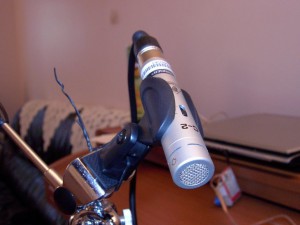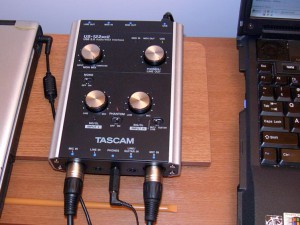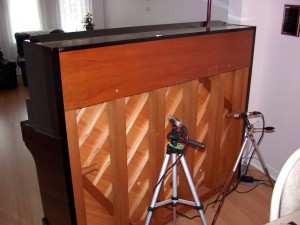A new pair microphones: Behringer C-2 ($65). The microphones use XLR connectors and require 48V phantom power. A Tascam US-122MkII ($90) serves as phantom power supply, microphone preamp, and USB audio interface (96 kHz, 24-bit). The two microphone cables (XLR F – XLR M) were expensive ($7 each).
Microphone placement turns out to significantly affect the sound, and is rather challenging to get right. After many hours of trial-record-and-error, I’ve settled on two that seem to sound reasonable. One placement is with the microphones in front of the piano at roughly the height of the tone release ports. The other is behind the piano at a similar height. The rear placement seems to have harsher treble hammer attack, but has lower noise from the key mechanism, page flipping, and pedals. (Placements are subject to continual improvement :D)
The previous recording equipment consisted of two electret capsules attached to the piano with suction cups (see them on top of the piano?). They were good for their price (~$0 — scrap parts), but they could always be better.
Here are some recording samples. The first two record the same performance with different equipment. The third is a separate performance.
- Old electret mics on suction cups (with 12dB bass boost below 110 Hz)
- New microphones, front (with some equalization)
- New microphones, rear (with some equalization)
I never figured out good equalizer settings for the old microphones, so I settled with just bass boost. The new microphones sound better with some trial-and-error equalization. I think I prefer the rear placement more. The new equipment sounds better to me, but I still don’t think it sounds close enough to a grand piano.
Next: Piano upgrade?



